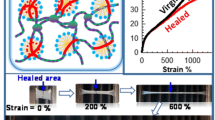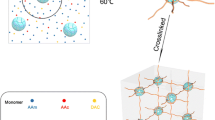Abstract
In this study, hydrophobic modified poly(acrylamide/octadecyl acrylate) (poly(AAm/C18)) and poly(acrylamide/octadecyl acrylate)-carboxymethyl cellulose (poly(AAm/C18)-CMC) hydrogels with high mechanical strength and shape memory properties were synthesized by random copolymerization method. Hydrogel synthesis was successfully carried out in one step on the basis of the hydrophobic monomer units carrying alkyl side chains included in the hydrophilic polymer network, and these hydrophobes clustered in water and acted as crosslinks. Hydrogels were characterized by Fourier transform infrared spectroscopy (FTIR), thermal gravimetric analysis (TGA), Differential scanning calorimetry (DSC), scanning electron microscopy (SEM) and X-ray diffractometry (XRD). The results showed that with the increase of the amount of hydrophobic monomer (C18) in the hydrogels, the crystal regions in the hydrogel structure increased. The swelling behaviour of the hydrogels was investigated as a function of the hydrophobic monomer content. Experimental swelling data confirmed the DSC and XRD results. The shape memory properties of hydrogels containing CMC were investigated. The new shape of the hydrogels was fixed by complexation between CMC and metal (M2+ and M3+ valence) ions.














Similar content being viewed by others
Data Availability
Not applicable.
References
Gholamali I, Yadollahi M (2020) Doxorubicin-loaded carboxymethyl cellulose/starch/ZnO nanocomposite hydrogel beads as an anticancer drug carrier agent. Int J Biol Macromol 160:724–735. https://doi.org/10.1016/j.ijbiomac.2020.05.232
Yang Y, Liu Y, Chen S, Cheong K, Teng B (2020) Carboxymethyl β-cyclodextrin grafted carboxymethyl chitosan hydrogel-based microparticles for oral insulin delivery. Carbohydr Polym 246:116617. https://doi.org/10.1016/j.carbpol.2020.116617
Muya FN, Sunday CE, Baker P, Iwuoha E (2016) Environmental remediation of heavy metal ions from aqueous solution through hydrogel adsorption: a critical review. Water Sci Technol 73:983–992. https://doi.org/10.2166/wst.2015.567
Tejo-Otero A, Ritchie AC (2021) Biological and mechanical evaluation of mineralized-hydrogel scaffolds for tissue engineering applications. J Biomater Appl 36:460–473. https://doi.org/10.1177/0885328221995425
Tang L, Huang Y, Lin C, Qiu B, Guo L, Luo F, Lin Z (2020) Highly sensitive and selective aflatoxin B1 biosensor based on exonuclease I-catalyzed target recycling amplification and targeted response aptamer-crosslinked hydrogel using electronic balances as a readout. Talanta 214:120862. https://doi.org/10.1016/j.talanta.2020.120862
Akalın GO, Pulat M (2020) Controlled release behavior of zinc-loaded carboxymethyl cellulose and carrageenan hydrogels and their effects on wheatgrass growth. J Polym Res 27:6. https://doi.org/10.1007/s10965-019-1950-y
Ahmed EM (2015) Hydrogel: Preparation characterization and applications: a review. J Adv Res 6:105–121. https://doi.org/10.1016/j.jare.2013.07.006
Jiang H, Duan L, Ren X, Guanghui G (2019) Hydrophobic association hydrogels with excellent mechanical and self-healing properties. Eur Polym J 112:660–669. https://doi.org/10.1016/j.eurpolymj.2018.10.031
Akça Ö, Yetişkin B, Okay O (2019) Hydrophobilcally modified nanocomposite hydrogels with self-healing ability. J Appl Polym Sci 137:48853. https://doi.org/10.1002/app.48853
Brisht HS, Pande PP, Chatterje AK (2002) Docosly acrylate modified polyacrylic acid synthesis and crystallinity. Eur Polym J 38:2355–2358. https://doi.org/10.1016/S0014-3057(02)00143-X
Wang F, Yong X, Deng J, Wu Y (2018) Poly(N, N-dimethylacrylamide-octadecyl acrylate)-clay hydrogels with high mechanical properties and shape memory ability. RSC Adv 8:16773–16780. https://doi.org/10.1039/C8RA01167B
Akalin GO, Pulat M (2018) Preparation and characterization of nanoporous sodium carboxymethyl cellulose hydrogel beads. J Nanomater 2018:9676949. https://doi.org/10.1155/2018/9676949
Li N, Chen G, Chen W, Huang J, Tian J, Wan X, He M, Zhang H (2017) Multivalent cations-triggered rapid shape memory sodium carboxymethyl cellulose/polyacrylamide hydrogels with tunable mechanical strength. Carbohydr Polym 178:159–165. https://doi.org/10.1016/j.carbpol.2017.09.030
Yang X, Guo M, Wu Y, Xue S, Xia Y, Zhang R, Wang H, Guo Q (2019) A facile approach for polymer hydrogels with enhanced strength, self-healing and multi-responsive shape memory properties. Mater Res Express 6:125340. https://doi.org/10.1088/2053-1591/ab5d61
Britton HTS, Robinson RA (1931) CXCVIII.—Universal buffer solutions and the dissociation constant of veronal. J Chem Soc (Resumed). https://doi.org/10.1039/JR9310001456
Gea S, Reynolds CT, Roohpour N, Wirjosentono B, Soykeabkaew N, Bilotti E, Peijs T (2011) Investigation into the structural, morphological, mechanical and thermal behaviour of bacterial cellulose after a two-step purification process. Bioresour Technol 102(19):9105–9110. https://doi.org/10.1016/j.biortech.2011.04.077
Sinha V, Chakma S (2020) Synthesis and evaluation of CMC-g-AMPS/Fe/Al/AC composite hydrogel and their use in fluoride removal from aqueous solution. Environ Technol Innov 17:100620. https://doi.org/10.1016/j.eti.2020.100620
Jeong D, Kim C, Kim Y, Jung S (2020) Dual crosslinked carboxymethyl cellulose/polyacrylamide interpenetrating hydrogels with highly enhanced mechanical strength and superabsorbent properties. Eur Polym J 127:109586. https://doi.org/10.1016/j.eurpolymj.2020.109586
El-Sayed S, Mahmoud KH, Fatah AA, Hassen A (2011) TGA and dielectric properties of carboxymethyl cellulose/polyvinyl alcohol blends. Phys B: Condens Matter 406:4068–4076. https://doi.org/10.1016/j.physb.2011.07.050
Bilici C, Okay O (2013) Shape memory hydrogels via micellar copolymerization of acrylic acid and n-octadecyl acrylate in aqueous media. Macromolecules 46:3125–3131. https://doi.org/10.1021/ma400494n
Yasin A, Zhou W, Yang H, Li H, Chen Y, Zhang X (2015) shape memory hydrogel based on a hydrophobically-modified polyacrylamide (hmpam)/α-cd mixture via a host-guest approach. Macromol J 36:845–851. https://doi.org/10.1002/marc.201400698
Yang F, Li G, He YG, Ren FX, Wang G (2009) Synthesis, characterization, and applied properties of carboxymethyl cellulose and polyacrylamide graft copolymer. Carbohydr Polym 78:95–99. https://doi.org/10.1016/j.carbpol.2009.04.004
Zhang Q, Wang Q, Jiang J, Zhan X, Chen F (2015) Microphase structure, crystallization behavior, and wettability properties of novel fluorinated copolymers poly(perfluoroalkyl acrylate-co-stearyl acrylate) containing short perfluorohexyl chains. Langmuir 35:4752–4760. https://doi.org/10.1021/la504467m
Mizuno Y, Watanabe S, Taguchi T (2020) Tissue-sealing and anti-adhesion properties of an in situ hydrogel of hydrophobically-modified Alaska pollock-derived gelatin. Int J Biol Macromol 163:2365–2373. https://doi.org/10.1016/j.ijbiomac.2020.09.084
Caykara T, Birlik G, İzol D (2007) Reentrant phase transition and network parameters of hydrophobically modified poly[2-(diethylamino)ethylmethacrylate-co-N-vinyl-2-pyrrolidone/octadecyl acrylate] hydrogels. Eur Polym J 43:514–521. https://doi.org/10.1016/j.eurpolymj.2006.11.008
Muhamad II, Fen LS, Hui NH, Mustapha NA (2011) Genipin-cross-linked kappa-carrageenan/carboxymethyl cellulose beads and effects on beta-carotene release. Carbohydr Polym 83:1207–1212. https://doi.org/10.1016/j.carbpol.2010.09.021
Kumar B, Priyadarshi R, Sauraj DF, Kulshreshtha A, Gaikwad KK, Kim J, Kumar A, Negi YS (2020) Nanoporous sodium carboxymethyl cellulose-g-poly (Sodium Acrylate)/FeCl3 hydrogel beads: synthesis and characterization. Gels 6:49. https://doi.org/10.3390/gels6040049
Acknowledgements
The first author thanks to the second author who lost her life on 6th February, 2023 because of the earthquake occurred in Turkey for being the best friend, scientist, beloved wife and mother. She will be remembered forever in our hearts. The authors are thankful to the Scientific Research Projects Coordination Unit of Hatay Mustafa Kemal University [Project Number: 20.M.057] for their financial support.
Funding
Scientific Research Projects Coordination Unit of Hatay Mustafa Kemal University [Project number: 20.M.057]. Hatay Mustafa Kemal University, 20.M.057, 20.M.057
Author information
Authors and Affiliations
Contributions
MS: Writing—original draft preparation, Conceptualization, Methodology, Writing—review & editing. CB: Writing—original draft preparation, Conceptualization, Methodology, Writing—review & editing.
Corresponding author
Ethics declarations
Competing interests
Not applicable.
Ethical Approval
Not applicable.
Consent to Participate
Not applicable.
Consent for Publication
Not applicable.
Additional information
Publisher's Note
Springer Nature remains neutral with regard to jurisdictional claims in published maps and institutional affiliations.
Rights and permissions
Springer Nature or its licensor (e.g. a society or other partner) holds exclusive rights to this article under a publishing agreement with the author(s) or other rightsholder(s); author self-archiving of the accepted manuscript version of this article is solely governed by the terms of such publishing agreement and applicable law.
About this article
Cite this article
Olukman Şahin, M., Demirbilek Bucak, C. Hydrophobically Associated Poly(acrylamide/octadecyl acrylate)-Carboxymethyl Cellulose Hydrogels: Synthesis, Characterization, and Shape Memory Ability. J Polym Environ 31, 3650–3663 (2023). https://doi.org/10.1007/s10924-023-02807-z
Accepted:
Published:
Issue Date:
DOI: https://doi.org/10.1007/s10924-023-02807-z




